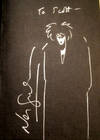
Aspects of the Novel
by E. M. Forster
- Used
- Hardcover
- first
- Condition
- Very Good Indeed
- Seller
-
BATH, Somerset, United Kingdom
Payment Methods Accepted
About This Item
Synopsis
The Clark Lectures, sponsored by Trinity College of the University of Cambridge, have had a long and distinguished history and have featured remarks by some of England's most important literary minds. Leslie Stephen, T.S. Eliot, F.R. Leavis, William Empson and I.A. Richards have all given celebrated and widely influential talks as the keynote speaker. One of the Lectures' most important milestones came in 1927 when, for the first time, a novelist was invited to speak. E.M. Forster had recently published his masterpiece, A Passage to India, and rose to the occasion, delivering eight spirited and penetrating lectures on the novel. The decision to accept the lectureship was actually a difficult one for Forster, as he had deeply ambivalent feelings about the use of criticism. Although suspecting that criticism was somewhat antithetical to creation, and upset by the thought that time spent preparing for the lectures was time away from his own work, Forster accepted. His talks were witty and informal, and they consisted of sharp, penetrating bursts of insight rather than overly-methodical analysis. They were a great success. Published later as Aspects of the Novel, the ideas articulated in his lectures would gain widespread recognition and currency in twentieth century criticism.Of all the insights contained in Aspects of the Novel, none has been more influential or widely discussed than Forster's discussion of "flat" and "round" characters. So familiar by now as to seem commonplace, Forster's distinction is meant to categorize the different qualities of characters in literature and examine the purposes to which they are put. A "flat" character, according to Forster, can be summed up n a single sentence and acts as a function of only a few fixed character traits. "Round" characters are capable of surprise, contradiction, and change; they are representations of human beings in all of their complexity. Forster's aim, however, is not to elevate the round at the expense of the flat, although he admits that the round is on the whole always a more interesting creation. Instead, he argues that there are compelling artistic reasons for a novelist to employ flat characters. And there are unquestionably great novelists, such as Dickens, who use only flat characters.Yet it would be a mistake to reduce this book to its most famous line of argument. Aspects of the Novel also discusses the difference between story and plot, the characteristics of prophetic fiction, and narrative chronology. Throughout, Forster draws on his extensive readings in English, French and Russian literature, and discusses his ideas in reference to such figures as Joyce, Tolstoy, Dostoevsky, James, Sterne, Defoe and Proust.A landmark in literary criticism, Aspects of the Novel has also provoked its fair share of disagreement. There are many critics who take issue with Forster's method as well has his conclusions, but the extent to which this work has come under attack is in many ways just another measure of its vitality.
Reviews
(Log in or Create an Account first!)
Details
- Bookseller
- Rooke Books
(GB)
- Bookseller's Inventory #
- 780A36
- Title
- Aspects of the Novel
- Author
- E. M. Forster
- Illustrator
- None
- Format/Binding
- Cloth
- Book Condition
- Used - Very Good Indeed
- Quantity Available
- 1
- Edition
- First edition
- Binding
- Hardcover
- Publisher
- Edward Arnold & Co.
- Place of Publication
- London
- Date Published
- 1927
- Size
- 7.5" by 5"
- Keywords
- em forster english novel lectures english novel
Terms of Sale
Rooke Books
Books are sent on approval and may be returned in like condition for any reason within 14 days of receipt. Responsibility of return to be with the purchaser.
About the Seller
Rooke Books
About Rooke Books
We are a small team dedicated to bringing you very scarce books at reasonable prices. We specialise in rare and hard to come by works on all subjects over the last 500 years, together with modern first editions and decorative sets and bindings. Our library has something for every interest and specialism. We deliver worldwide using a fully tracked and insured courier delivery service.
Where are We?
Based in the literary city of Bath, our offices are housed in the Eastern Dispensary. Built in 1845, the building originally existed as a charitable institution providing medical care. The building now houses our collection of over twenty thousand books and has five full time members of staff.
Glossary
Some terminology that may be used in this description includes:
- First Edition
- In book collecting, the first edition is the earliest published form of a book. A book may have more than one first edition in...
- Leaves
- Very generally, "leaves" refers to the pages of a book, as in the common phrase, "loose-leaf pages." A leaf is a single sheet...
- Gutter
- The inside margin of a book, connecting the pages to the joints near the binding.
- Cloth
- "Cloth-bound" generally refers to a hardcover book with cloth covering the outside of the book covers. The cloth is stretched...
- Spine
- The outer portion of a book which covers the actual binding. The spine usually faces outward when a book is placed on a shelf....
- Shelf Wear
- Shelf wear (shelfwear) describes damage caused over time to a book by placing and removing a book from a shelf. This damage is...
- Tail
- The heel of the spine.
- Edges
- The collective of the top, fore and bottom edges of the text block of the book, being that part of the edges of the pages of a...
- Publisher's cloth
- A hardcover book comprised of cloth over hard pasteboard boards. ...







